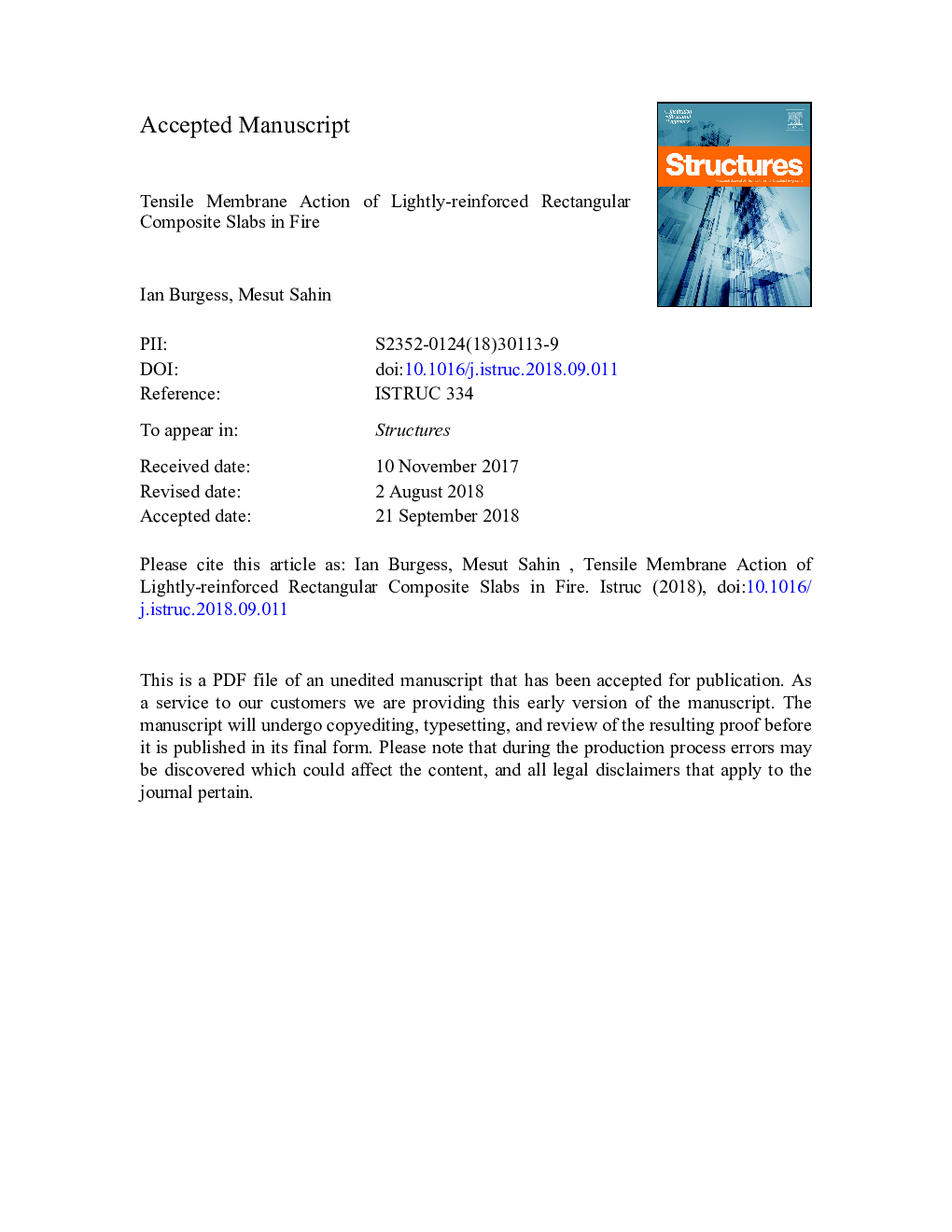| کد مقاله | کد نشریه | سال انتشار | مقاله انگلیسی | نسخه تمام متن |
|---|---|---|---|---|
| 11032525 | 1645553 | 2018 | 59 صفحه PDF | دانلود رایگان |
عنوان انگلیسی مقاله ISI
Tensile Membrane Action of Lightly-reinforced Rectangular Composite Slabs in Fire
ترجمه فارسی عنوان
اثر غشای کششی از صفحات کامپوزیت مستطیلی مقاوم در برابر آتش در آتش
دانلود مقاله + سفارش ترجمه
دانلود مقاله ISI انگلیسی
رایگان برای ایرانیان
کلمات کلیدی
اسلب کامپوزیت آتش، عمل غشای کششی، تئوری خط تولید
ترجمه چکیده
یک روش اخیرا برای درمان اعمال غشاء کششی از اسلبهای بتنی سبک شده بر اساس رفتار دقیق سینماتیک حرکت مکانیزم خط تولید، به منظور بررسی پوسته های کامپوزیتی با تیرهای فولادی کم مقاومت در شرایط آتش سوزی توسعه یافته است. مورد آتش از افزایش ظرفیت بار اسلب ها در دمای محیط متفاوت است با توجه به اینکه بارگذاری اعمال شده در یک مقدار از پیش تعیین شده ثابت نگه داشته می شود، اما مقاومت پرتاب های پیشرو در افزایش دما افزایش می یابد. فرض بر این است که بتن های بتنی در طول فعالیت های خود به میزان کافی برای کاهش قدرت خود، در طول مدت آتش افزایش نمی یابد. این فرمت به روش مشتق شده است. دیده می شود که مکانیسم های عملکرد خطی این اسلب ها متفاوت از اسلب های بتنی مشابه است، بنابراین معتبر نیست که از آن به عنوان پایه محاسبه طراحی استفاده شود. مزایای انحرافات محدود به علت عمل غشای کششی خود را به عنوان افزایش دمای پرتو فولادی که می تواند پایدار باشد، نشان می دهد، بالاتر از آن که مکانیزم خط تولید آن تشکیل شده است. افزایش اوج در نقطه ای است که در آن تقویت کننده مشکوک به طور مداوم در طول خطوط تولید مورب شروع به شکست می کند. این شکست ممکن است با تاخیر و افزایش دما در اوج افزایش یابد، در صورتی که ورق مش در عرض تراز خط تولید با کاهش پیوند بین میله ها و بتن افزایش می یابد، بنابراین لغزش نوار از چهره های چروکی تسهیل می شود. اثرات استفاده از مش از کلاس های مختلف تنفس، و هر دو میله های ساده و ناهموار، برای اسلب های کامپوزیتی از نسبت های مختلف جنبه در نظر گرفته شده است.
موضوعات مرتبط
مهندسی و علوم پایه
سایر رشته های مهندسی
مهندسی عمران و سازه
چکیده انگلیسی
A recently developed method of treating tensile membrane action of lightly reinforced concrete slabs, based on a rigorous treatment of the kinematics of movement of the yield-line mechanism, has been developed to consider composite slabs with unprotected downstand steel beams in fire conditions. The fire case differs from the enhancement of load capacity of slabs at ambient temperature in the respect that the applied loading is kept constant at a predetermined value, but the strength of the downstand beams progressively declines as their temperature rises. It is assumed that the concrete slab does not become hot enough in its active levels, within the duration of a fire, to reduce its strength. This extension to the method is derived systematically. It is seen that the yield line mechanisms of these slabs are aligned differently from those of the equivalent concrete slabs, so it is not valid to use the latter as the basis of a design calculation. The advantage of finite deflection due to tensile membrane action manifests itself as an enhancement of the steel beam temperature that can be sustained, above that at which the yield line mechanism forms. The peak enhancement occurs at the point at which reinforcing mesh begins to fracture progressively along diagonal yield lines. This fracture can be delayed and the peak temperature increased if the mesh ductility across the yield line cracks is increased by reducing the bond between bars and concrete, thus facilitating the bar-slip from the crack-faces. The effects of using meshes of different ductility classes, and both plain and deformed bars, are considered for composite slabs of different aspect ratios.
ناشر
Database: Elsevier - ScienceDirect (ساینس دایرکت)
Journal: Structures - Volume 16, November 2018, Pages 176-197
Journal: Structures - Volume 16, November 2018, Pages 176-197
نویسندگان
Ian Burgess, Mesut Sahin,
